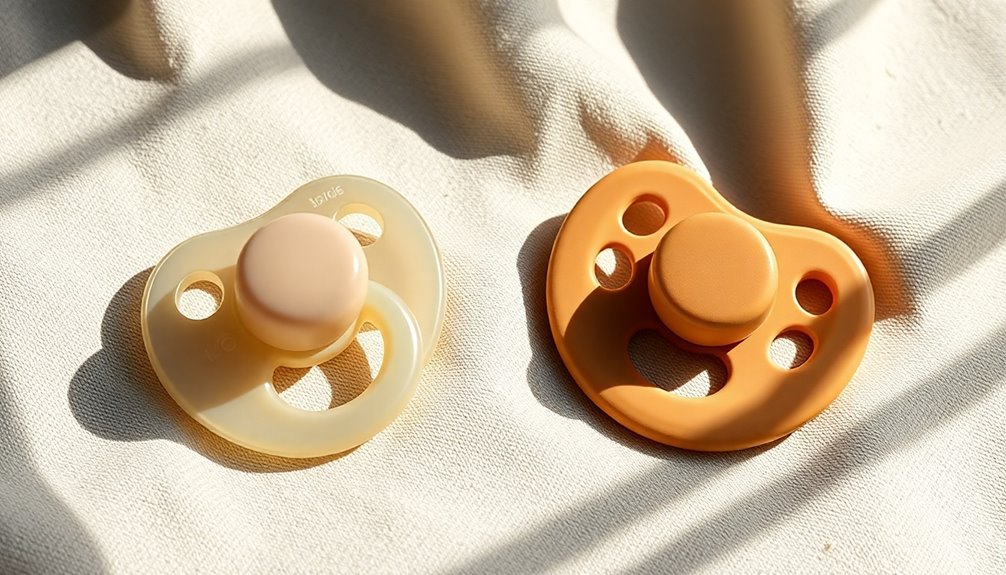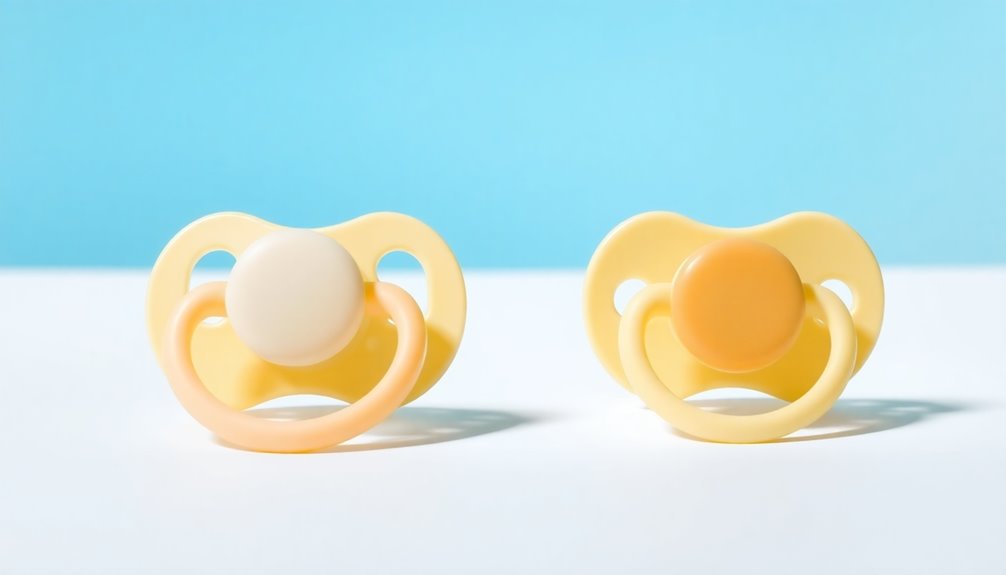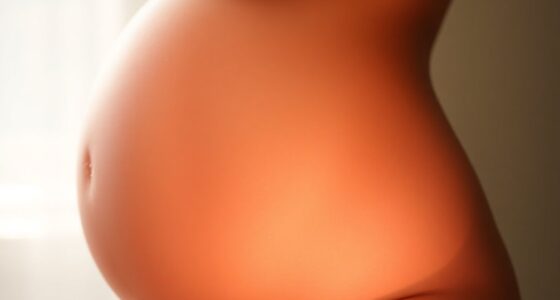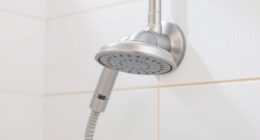If you're torn between silicone and rubber pacifiers, silicone's got the edge! They're durable, easy to clean, and hypoallergenic—perfect for babies with latex allergies. In contrast, rubber pacifiers can cause allergic reactions and need replacing more often. While some babies prefer the soft feel of rubber, silicone pacifiers won't degrade or get sticky over time. Want to know more about choosing the right pacifier for your little one and what others think? Keep going!
Key Takeaways
- Silicone pacifiers are hypoallergenic and safe for babies with latex allergies, while rubber pacifiers may cause allergic reactions in sensitive infants.
- Silicone pacifiers have a longer lifespan and are more durable, lasting several months without significant degradation compared to rubber pacifiers.
- Cleaning silicone pacifiers is easier; they can be boiled, while rubber pacifiers require scalding to prevent damage.
- Natural rubber pacifiers offer a softer feel, closely resembling a mother's breast, appealing to some infants' comfort preferences.
- Silicone pacifiers are non-biodegradable, while rubber pacifiers are eco-friendly and biodegradable, influencing environmental considerations in your choice.
Understanding Pacifier Materials

When you're choosing a pacifier for your baby, it's essential to understand the materials involved.
Silicone pacifiers are made from industrially manufactured, hypoallergenic materials that are free of harmful chemicals. They're easy to clean and last longer, resisting degradation from heat and sunlight.
Silicone pacifiers are hypoallergenic, durable, and easy to clean, making them a safe choice for your baby.
On the other hand, natural rubber latex pacifiers are softer and more flexible, closely mimicking a mother's breast. However, they're made from the milky fluid of the Hevea tree and can cause allergic reactions in sensitive babies.
Both types should be replaced every 4-6 weeks for hygiene, but keep in mind that latex may need more frequent replacement due to its sensitivity to environmental factors.
Weigh these characteristics to find the best fit for your little one.
The Benefits of Silicone Pacifiers
Choosing a pacifier for your baby can be overwhelming, but silicone pacifiers offer several clear advantages.
First, they're highly durable and resistant to wear, lasting much longer than latex options, which can degrade. If your baby has a latex allergy, silicone pacifiers are a great alternative since they're made from hypoallergenic materials, free from harmful chemicals like BPA, PVC, and phthalates.
You'll appreciate how easy they're to clean and sterilize; just boil or microwave them without losing their shape. Plus, silicone pacifiers are taste-neutral and odorless, making them more appealing to your little one.
With ventilation holes, they promote airflow and comfort, enhancing the soothing experience for your baby.
The Advantages of Rubber Pacifiers

Rubber pacifiers offer some unique advantages that you might find appealing.
Their natural material provides a soft and flexible feel, closely resembling a mother's nipple, which can soothe your baby effectively.
Plus, they're eco-friendly and biodegradable, making them a great choice for environmentally-conscious parents.
Natural Material Benefits
While many parents seek safe and eco-friendly options for their infants, natural rubber pacifiers stand out for their unique advantages.
Made from the milky fluid of the Hevea tree, these latex pacifiers are biodegradable and environmentally friendly, making them a sustainable choice. They're free from harmful chemicals like BPA, PVC, and phthalates, ensuring a safer experience for your little one.
Plus, natural rubber pacifiers closely mimic the soft texture of a mother's breast, providing comforting relief when needed. They're hypoallergenic, but it's wise to check for any latex allergies before use.
To maintain hygiene, remember to replace rubber pacifiers every 4-6 weeks, preventing degradation from exposure to air, UV light, and heat. Additionally, the use of renewable resources in products like rubber pacifiers supports sustainable practices that benefit the environment.
Soft and Flexible Feel
Parents often appreciate the soft and flexible feel of natural rubber pacifiers, which can greatly enhance an infant's comfort. Made from rubber that's as soft as latex, these pacifiers mimic a mother's breast, making them soothing for babies. Their elasticity adapts to your baby's sucking patterns, easing the shift from breastfeeding to pacifier use. While silicone can feel firmer, rubber provides a familiar sensation that many infants prefer, especially during teething or fussy periods. Keep in mind, rubber pacifiers may need more frequent replacement, but their comfort benefits are worth it.
| Feature | Rubber Pacifiers |
|---|---|
| Material | Natural rubber latex |
| Softness | Soft as latex |
| Flexibility | Highly flexible |
| Transition Aid | Aids breastfeeding shift |
Eco-Friendly and Biodegradable
When considering pacifier options, it's important to recognize the eco-friendly benefits of rubber pacifiers. Made from natural rubber latex sourced from the Hevea tree, these pacifiers are biodegradable, making them a more sustainable choice compared to synthetic silicone.
Since natural rubber breaks down more easily in landfills, you'll help reduce environmental impact. Additionally, the production of rubber has a lower carbon footprint, aligning with your eco-conscious values.
Rubber pacifiers also offer a softer, more flexible feel that mimics a mother's breast, providing your baby with extra comfort. Just remember to replace them every 4-6 weeks to maintain hygiene.
Safety Concerns: Toxins and Allergies

When choosing between silicone and rubber pacifiers, you need to take into account potential toxins and allergies.
Silicone pacifiers are often hypoallergenic and free from harmful chemicals, while natural rubber can trigger sensitivities in some infants.
Always check for safe product certifications to guarantee you're making the healthiest choice for your baby.
Material Toxicity Risks
How do you choose a pacifier that's safe for your baby?
When considering silicone or latex options, it's essential to weigh material toxicity risks. Silicone pacifiers are generally safer, being hypoallergenic and free from harmful chemicals like BPA and phthalates.
On the other hand, natural rubber pacifiers can pose allergy risks for babies sensitive to latex and may leach nitrosamines, which are potential carcinogens. While they meet EU safety standards, caution is advised for long-term use.
Opt for medical-grade silicone pacifiers to avoid lead contamination, as lower-grade silicone can contain harmful substances.
Regularly inspect and replace both types every 4-6 weeks to maintain hygiene and minimize material degradation.
Prioritize non-toxic certifications to guarantee your baby's safety.
Allergy Considerations
Material toxicity isn't the only concern when selecting a pacifier; allergies also play a significant role. If your baby has a latex allergy, opting for silicone pacifiers is a smarter choice. Silicone is generally hypoallergenic and free from harmful chemicals, while latex pacifiers can cause allergic reactions in sensitive infants.
Here are some key points to evaluate:
- Hypoallergenic Options: Silicone pacifiers are less likely to trigger allergies.
- Material Lifespan: Latex pacifiers degrade over time and should be replaced every 4-6 weeks to prevent allergen buildup.
- Chemical Safety: Some latex products may contain nitrosamines, raising long-term safety concerns.
Always prioritize your baby's health by choosing pacifiers that are both safe and suitable for their needs.
Safe Product Certifications
Choosing a pacifier that meets safety certifications can greatly impact your baby's health. When selecting pacifiers, look for ones that are BPA-free, PVC-free, and phthalate-free to guarantee they're safe from harmful chemicals.
If you opt for natural rubber, make sure it's free from artificial colors and chemicals, and check for any latex allergies. Medical grade silicone pacifiers are your best bet to avoid lead contamination and other harmful substances often present in lower-grade options.
Always verify compliance with safety standards, particularly those set by the EU concerning nitrosamines in rubber products.
Don't forget to replace pacifiers regularly, ideally every 4-6 weeks, to maintain hygiene and minimize exposure to potential toxins.
Durability and Lifespan Comparison

When considering durability and lifespan, silicone pacifiers stand out as a more reliable option than their rubber counterparts.
You'll find that silicone pacifiers typically last several months without significant degradation, whereas rubber pacifiers need replacement every 4-6 weeks.
Here are some key differences:
- Longevity: Silicone maintains its shape and structure longer, often lasting several months.
- Resistance to Wear: Rubber pacifiers can degrade within three months, especially with exposure to sunlight and oils.
- Hygiene: Silicone pacifiers don't absorb oils and are less prone to cracking, making them easier to clean.
Cleaning and Maintenance Tips

To keep your baby's pacifier in top condition, regular cleaning and maintenance are vital.
For silicone pacifiers, boil them for 5-10 minutes or use a microwave sterilizer. If you have natural rubber pacifiers, scald them instead of boiling to prevent degradation.
It's important to replace both types every 4-6 weeks to maintain hygiene and prevent wear. Silicone pacifiers are more hygienic since they don't absorb oils, while latex can become sticky over time.
Store latex pacifiers in a cool, dry place, but silicone can be stored without worries.
Regularly inspect for cracks, discoloration, or any signs of wear to guarantee they remain safe for your baby.
Prioritize these cleaning and maintenance tips to keep your little one healthy!
Choosing the Right Pacifier for Your Baby

What factors should you consider when selecting the right pacifier for your baby? Choosing between silicone and rubber can be challenging, but keeping a few key points in mind will help.
- Durability: Silicone pacifiers are generally more durable and easier to clean, making them a practical option for busy parents.
- Texture Preference: Some babies prefer the softer feel of natural rubber, while others like the firmer texture of silicone. Observe your baby's reactions to both materials.
- Hygiene and Replacement: Remember to replace both types every 4-6 weeks to maintain hygiene.
Also, consider the environmental impact: natural rubber is biodegradable, while silicone is not.
Make a choice that aligns with your values and your baby's comfort!
User Experiences and Recommendations

Many parents share their experiences when choosing between silicone and rubber pacifiers, highlighting the importance of personal preference and baby comfort.
Many users prefer silicone pacifiers for their lack of aftertaste and easy cleaning. Parents with children who've latex allergies often recommend silicone as a hypoallergenic alternative.
They appreciate that silicone pacifiers tend to last longer without degrading, while latex options may need replacing more frequently. Additionally, silicone doesn't absorb oils, making it more hygienic and less sticky over time.
Ultimately, personal comfort and your baby's preferences play a significant role in your choice. Many parents suggest trying both types to see which one your baby prefers, ensuring a happier experience for both you and your little one.
Frequently Asked Questions
Is Silicone or Rubber Pacifier Better?
When deciding between silicone and rubber pacifiers, consider your baby's needs and sensitivities.
Silicone pacifiers are durable, easy to clean, and hypoallergenic, making them ideal for babies with latex allergies.
On the other hand, rubber pacifiers are softer and may feel more comforting to some infants.
Both types should be replaced every 4-6 weeks for hygiene, but silicone tends to last longer.
Ultimately, choose what works best for your baby's comfort and safety.
Is Rubber or Silicone Better for Babies?
When deciding whether rubber or silicone is better for your baby, consider their needs.
Silicone pacifiers are more durable and hypoallergenic, making them a safe choice if allergies are a concern. On the other hand, rubber pacifiers are softer and can be more comforting for some babies.
Both types should be replaced every 4-6 weeks for hygiene, but silicone tends to last longer without losing shape.
Ultimately, it depends on your baby's preferences and sensitivities.
Is Silicone or Rubber Teether Better?
You might think rubber teethers are the best option because they're softer, but silicone teethers have their advantages too.
Silicone is hypoallergenic and durable, making it a safer choice for many babies. Plus, you can easily sterilize them, ensuring your little one stays healthy.
While rubber may feel nice, it can cause allergic reactions in some infants.
Ultimately, it's about finding what works best for your baby's needs and preferences.
Which Is Safer, Rubber or Silicone?
When considering safety, silicone pacifiers typically come out on top.
They're made from food-grade materials, free from harmful chemicals like BPA and phthalates, which is essential for your baby's health.
While rubber pacifiers can be softer and mimic a breast, they may contain natural latex, posing allergy risks.
Plus, silicone lasts longer and is easier to clean.
For peace of mind, you might want to stick with silicone for your little one.
Conclusion
In the end, choosing between silicone and rubber pacifiers isn't just about preference; it's about what suits your baby's needs best. While silicone offers durability and easy cleaning, rubber brings a softer, more natural feel. Both have their benefits and safety considerations, so weigh your options carefully. Ultimately, trust your instincts and listen to your baby's cues. With the right pacifier, you can soothe your little one and give them the comfort they crave.








